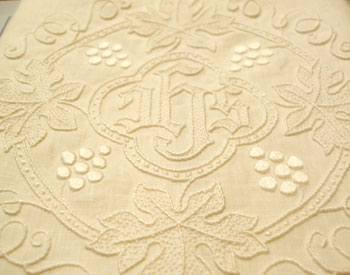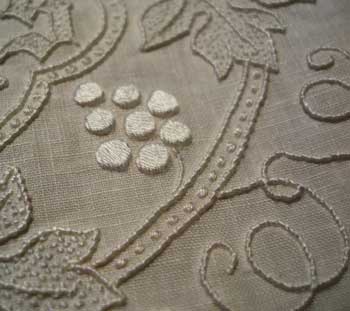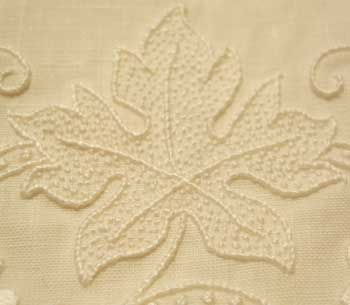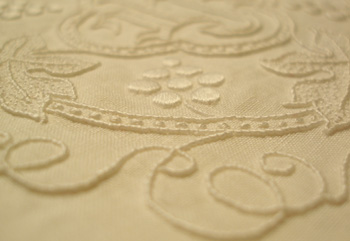Embroidery on white linen, in white threads, produces rich, elegant results. A while back, I mentioned a project I was working on, using simple stitches on white linen, but I flubbed up on part of it, and had to start again…
You can find the original post on the subject here. I ended up picking out part of the work, and consequently marring the linen.
I reworked the same project and finished it a couple weeks ago, so I thought I’d share some photos of it. Overall, my point in this little article is to encourage readers who might be intimidated by “detail” work, especially whitework, that looks hard. This project, as far as stitching is concerned, was relatively simple!
Here’s a photo of the overall piece, which is a white linen pall, a square piece of linen traditionally used to cover the chalice during the Mass. It’s approximately 6 inches square.

Although the color looks a bit creamy in the photo, the linen is “ecclesiastical linen” by Legacy, which is white, and the thread I used was a #30 coton a broder by DMC.

I stitched all the lines and scrolls in a whipped backstitch – a very simple stitch! I wanted to raise the outlines a little bit, to add dimension to the piece. The grapes are stitched in a lighly padded satin stitch, and these were probably the most difficult part of the piece, only because some stitches may find it difficult to satin stitch circles well at first. I didn’t necessarily want all the circles the same size or a perfectly “round” shape, but tried for at least some consistency! The insides of the double-outlined shapes (the outside circle and the inside quatrafoil) are stitched in larger seed stitches, using double stitches.

The inside of the leaves and the letters are worked with a seed stitch – tiny single stitches which I did not “randomly” work, but rather worked more or less in the direction of the leaf. Seed stitch may be randomly worked, in different directions, for a nice effect, but here I wanted something a little more organized looking.

Perhaps my favorite aspects of the piece are the dimension created by the whipped backstitch and the padded satin stitch, and the texture, provided by the seed stitches.
A hint when working white-on-white: use good lighting! It makes all the difference. For the whipped backstitch, keep your backstitches tiny and even, and do all the “whipping” in the same direction.







Beautiful work!!! makes me want to start on something like this. The close-up photos really help understand the stitches.
Thank you, I will definitely look at them. —-Linda K.
That is so beautiful! I’ve been looking forward to seeing this piece, and it’s even more wonderful than I’d imagined. I love the apparent (deceptive) simplicity of white on white and the flawlessness of your execution. So-called simple or basic stitches look their best when they’re worked so confidently. Thank you for posting with such helpful commentary.
What is a Seed Stitch? You use it in the piece for the leaves and letters. Thank you
Seed stitch is simply tiny straight stitches worked randomly to fill a space. They can all be stitched in one direction (as I did in the leaves above, following, more or less, the “design” of the leaf) or they can be worked in various directions, which gives a much more “random” look to the filling. They add texture and slight color (when using colored thread) rather than solid smooth color. You can see another example of seed stitch in the third and fourth photos on this page here. The area filled with the little speckles starting in the lower left hand corner of the fourth picture is worked with seed stitch (or “seeding” as it’s sometimes called).
When you’re doing a project this small, do you use an embroidery hoop, or do you do something different, like a frame or something?
I am learning so much from you!! Aside from the breathtaking work, your photos are crisp and close. I’ve been poring over your site and am learning not just execution of stitches but a sense of when to use different ones (that was what had always held me back before: got overwhelmed, so many choices, combinations—where to start??). I may get the confidence soon to try my hand at one of your beginner patterns.
I have kept so many wonderful white-on-white embroideries my grand-ma had given me and had no idea there were still people out there who knew how to do this. Thank you for keeping up the tradition, and for sharing your work with us. I shall pursue this as a hobby upon my retirement.
mary.I am so encouraged now to continue and not give up on my project,it is so helpfull to see the close up work and the way you describe in detail it is just beautifull.
I tried looking up some of your old posts for how to construct the pall, and most of the older ones aren’t accessible anymore 🙁 I have to log in to WordPress, which I’m unable to do.
Actually, they are all available – there’s just a little prob with the search mechanism on the site. I’m in the process of having that fixed… Anyway, any post you see in the search engine results that has “dev” before the rest of the URL is not accessible. But the real post itself still is. Just take the title of the post you want to read (that has “dev” in front of it) and type it into the search box. The live post will come up in the results. It won’t have “dev” in front of the URL. I know it’s not a convenient way of getting to the post, but it’s just a temporary fix, until I can sort out why the development site is being picked up by the search engine! Sorry!!!! ~MC
u r work is very intresting because in india we have no gain that type of stitches these stitches r new for me i m very thankful to u
Thanks v…v…much.I’m learning so much from u.From-Sri Lanka
Wow! I have been hand embroidering (self-taught) on & off for gee, 30 or so years, and have made many things, & don’t own any myself. Your embroidery is beautiful! Light always has to be good, but I find transfers a challenge now. Any ideas?
Hi, Brenda – There’s an article here on Needle ‘n Thread all about transferring patterns to fabric. You can find it here: https://needlenthread.wpengine.com/2010/09/beginning-embroidery-design-transfer.html Hope that helps! ~MC
Oh my goodness. I love this site! I was just referred to it. I am a beginner, although I did learn to do simple embroidery when I was in the Girl Scouts, at age 12. My interest lies in doing white on white hand embroidery. I want to learn to do raised monograms. I don’t know where to begin. Can you please give me some suggestions? What type of tools do I need? What materials? What books? Where do I get them? Instructions?
Please help me. I love to hear your story and how you followed your heart, pertaining to career.
I reside in Texas. Where do you live? Please guide me in the right direction.
Many thanks, for all the help that you can provide.
Deana Armstrong (my first name is pronounced Deena).
I live in Kansas, Deana. There are two very good instructional books available – you’ll find them both listed in the top spot on my Amazon recommendations page (under “browse my Amazon recommendations”), and then there’s a third book on that list (the third one listed) that’s a project book with whitework projects in it. All three are excellent books, but the first two are really instructional books that will get you started.
LOVE your web site!!!